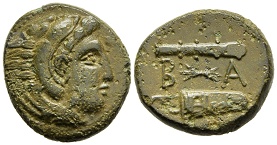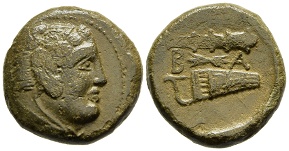Fine Coins Showcase
Recent Price Reductions
May 16, 2024
May 15, 2024
May 12, 2024
May 09, 2024
Home ▸ Catalog ▸ |Price ReductionsView Options:   | | | | | | |



This variety is unpublished in the primary references. Henri Hoffmann in Les Monnaies Royales De France Depuis Hugues Capet Jusqu'ã Louis XVI (1884) does list the 4 vice IIII legend variation on other types, a quarter ecu of Navarre and an eighth of Béarn and Navarre, for example. ME112523. Silver 1/4 Ecu, Ciani 1517 var., Duplessy 1224 var., Legros 1066 var., Hoffmann 28 var. (all rev. leg. IIII vice 4, etc.); cf. Hoffmann 29 (Navarre), VF, toned, weight 9.549 g, maximum diameter 29.3 mm, die axis 135o, Bayonne mint, 1590; obverse SIT•NOMEN+DOMINI•BENEDICVM (Blessed be the name of the Lord, Bayonne mintmark), crowned shield of France (three fleurs-de-lis), II - II flanking across field, Bayonne mintmark (and control marks) at 6:00: +L+(flower)(anchor); reverse + HENRICVS4•D•G•FRAN•E•NAVA•R•1590 (Henry IV, by the Grace of God, King of France and Navarre, 1590), Foliate cross, quatrefoil around cross of five pellets at center, lily arms, pellet at each end; ex Karl Stephens; $500.00 (€470.00)
Anglo-Gallic, Richard II, 1377 - 1399



Richard II's posthumous reputation has been shaped to a large extent by William Shakespeare, whose play Richard II portrayed Richard's misrule and his deposition as responsible for the 15th-century Wars of the Roses.ME113073. Silver Hardi d'Argent, Withers AGC 275B, 1/a; Elias 228a (S) var. (obv. legend); Duplessy Féodales 1136 var. (legends); SCBC-SII 8143, VF, dark toning, clashed obv. die, weight 1.184 g, maximum diameter 20.2 mm, die axis 135o, Aquitaine mint, 1377 - 1399; obverse Latin: RICARD' R• AGLIE (Richard King England), half-length figure of the king facing beneath Gothic canopy, sword in right hand resting on right shoulder, pointing with left hand; reverse Latin: FRA-CIE - DnS - AQI (France, Lord of Aquitaine), long cross pattée, leopard in first and fourth quarters, lis in second and third quarters; ex Gordon Andreas Singer (Greenbelt, MD); $480.00 (€451.20)
Anglo-Gallic, Richard II, 1377 - 1399



Richard II's posthumous reputation has been shaped to a large extent by William Shakespeare, whose play Richard II portrayed Richard's misrule and his deposition as responsible for the 15th-century Wars of the Roses.ME113074. Silver Hardi d'Argent, Withers AGC 275B, 13(?)/d; Elias 228a (S) var. (legends); Duplessy Féodales 1136 var. (legends); SCBC-SII 8143, aVF, dark tone, ink museum number on obverse, weight 0.886 g, maximum diameter 19.1 mm, die axis 345o, Aquitaine mint, 1377 - 1399; obverse Latin: RICARD' RX• AGLIE (or similar, Richard King England), half-length figure of the king facing beneath Gothic canopy, sword in right hand resting on right shoulder, pointing with left hand; reverse Latin: •FRAC-IE Dn-S•AQI-TAnE (France, Lord of Aquitaine), long cross pattée, leopard in first and fourth quarters, lis in second and third quarters; $400.00 (€376.00)
France, Henri II, 31 March 1547 - 10 July 1559



In June 1559, Henry was injured in a jousting tournament held to celebrate the treaty, the April 1559 Peace of Cateau-Cambrésis, which ended the Italian Wars. He died ten days later after his surgeon, Ambroise Paré, was unable to cure the wound.WO113445. Silver teston du moulin, Duplessy 989, Ciani 1279, Lafaurie 827, Roberts 3534, Sombart 4584, gF, toned, scratches and marks, weight 9.252 g, maximum diameter 28.0 mm, die axis 180o, Paris mint, 1553, type 3e; obverse HENRICVS. II. DEI. G. FRANCOR. REX (Henri II, by the grace of God, King of France), laureate head of the King right; reverse + CHRS VINCIT CHRS REGNAT CHRS IMP E 1553 (Christ conquers, Christ reigns, Christ commands), crowned shield arms of France, A below; first example of this type handled by Forum; ex Gordon Andreas Singer (Greenbelt, MD); scarce; $240.00 (€225.60)
Anglo-Gallic, Edward III, 25 January 1327 – 21 June 1377



The Aquitanian title on both sides seems to suggest this coin was struck c. 1325 - 1326, when Edward III was Duke of Aquitaine but not yet King of England, but Elias dates the type the second half of the 1350's based on style. This type and similar billon Anglo-Gallic coins looked silver when issued, but after some use turned black, hence their nickname, "black money." They were usually hastily and poorly struck, heavily circulated and worn, and seldom hoarded. Surviving examples are now rare and mostly low grade. This type is very rare.ME112522. Billon obole au lion, Elias 110c (RR), Duplessy Féodales 1109 var. (obv. title ED':REX: ARGLIE), Boudeau 503 var. (same), aVF, broken with fragment lost, clashed obv. die, deposits, corrosion, weight 0.489 g, maximum diameter 14.9 mm, die axis 270o, Bordeaux(?) mint, 4th type, 1350 - 1360; obverse + ED' : DVX : AeITANIE (Edward, Duke of Aquitaine), leopard passant left on straight line, mB' (Moneta Burdegalensis?) below line; reverse +DVX : AeITANIE (Duke of Aquitaine), short cross pattée within inner circle, pellet under crown in second angle; ex Gordon Andreas Singer, very rare with the Aquitanian title on both sides!; $210.00 (€197.40)
South Africa, Elizabeth II, 5 Shillings, 1959



Key date!UK112524. Silver 5 Shillings, SCWC KM52, Choice UNC, weight 28.200 g, maximum diameter 38.8 mm, die axis 0o, Pretoria mint, 1959; obverse ELIZABETH II REGINA, young laureate portrait of Queen Elizabeth II right; reverse SUID-AFRIKA · 1959 · SOUTH AFRICA (bilingual Afrikaans-English), springbok right, 5s below; rare; $390.00 (€366.60)
Macedonian Kingdom, Alexander the Great, 336 - 323 B.C.



Herakles is most often depicted on coinage wearing the scalp of the Nemean lion over his head. The first of Herakles' twelve labors, set by his cousin King Eurystheus, was to slay the Nemean lion and bring back its skin. Herakles discovered arrows and his club were useless against it because its golden fur was impervious to mortal weapons. Its claws were sharper than swords and could cut through any armor. Herakles stunned the beast with his club and, using his immense strength, strangled it to death. During the fight, the lion bit off one of his fingers. After slaying the lion, he tried to skin it with a knife but failed. Wise Athena, noticing the hero's plight, told him to use one of the lion's own claws to skin the pelt.MA112975. Bronze unit, Price 373, weight 4.612 g, maximum diameter 18.0 mm, die axis 90o, Macedonian mint, c. 325 - 310 B.C.; obverse head of Herakles right, wearing Nemean Lion skin, scalp over head, forepaws tied at neck; reverse club above, B fulmen (thunderbolt) A across center, bow in bowcase below; $26.00 (€24.44)
Macedonian Kingdom, Alexander the Great, 336 - 323 B.C.



Herakles is most often depicted on coinage wearing the scalp of the Nemean lion over his head. The first of Herakles' twelve labors, set by his cousin King Eurystheus, was to slay the Nemean lion and bring back its skin. Herakles discovered arrows and his club were useless against it because its golden fur was impervious to mortal weapons. Its claws were sharper than swords and could cut through any armor. Herakles stunned the beast with his club and, using his immense strength, strangled it to death. During the fight, the lion bit off one of his fingers. After slaying the lion, he tried to skin it with a knife but failed. Wise Athena, noticing the hero's plight, told him to use one of the lion's own claws to skin the pelt.MA112976. Bronze unit, Price 373, weight 5.656 g, maximum diameter 18.0 mm, die axis 90o, Macedonian mint, c. 325 - 310 B.C.; obverse head of Herakles right, wearing Nemean Lion skin, scalp over head, forepaws tied at neck; reverse club above, B fulmen (thunderbolt) A across center, bow in bowcase below; $13.00 (€12.22)
Medieval Spain, Bronze Scabbard Chape, c. 15th - 16th Century



In the London Museum medieval catalogue, Ward-Perkins dates similar chapes to the late 15th or 16th century. He suggests that metal dagger chapes were only used on the sheaths of military daggers or the more elaborate forms of civilian dagger. The great majority of surviving leather sheaths belonged to ordinary knives or knife-daggers and these have no metal terminal.AS110892. bronze scabbard chape, 54.2mm long, 15th - 16th century; hollow shield shaped, curved sides converging at the base, a solid rounded knob terminal, curved upper edge with a raised lip on the front, rectangular opening on the back; $45.00 (€42.30)
Roman Empire, Lot of 26 Bronze Coins, 26 Different Rulers, c. 40 - 450 A.D.



The following list was provided by the consignor and has not been verified by FORVM:
1) Claudius, as, Minerva; 2) Nero, billon tetradrachm, Alexandria, Apollo; 3) Vespasian, AE17, RPC II 966; 4) Titus as Caesar, AE12, Stobi, Macedon, temple, holed; 5) Domitian and Domitia, facing busts, RPC II 1262; 6) Hadrian, denarius, 1/3 broken off; 7) Antinous, lead tessera, Alexandria; 8) Marcus Aurelius Caesar, AE21, Sardes; 9) Julia Domna, AE21, Berytus; 10) Geta Caesar, AE18, Nikopolis, Moesia Inferior; 11) Macrinus, AE20, Antioch, SC in wreath; 12) Diadumenian Caesar, AE24, Deultum, Artemis firing bow; 13) Philip I, antoninianus; 14) Herennius Etruscus, AR antoninianus, extensively chipped;; 15) Tetricus I, antoninianus, Spes standing, RIC 136; 16) Galerius Caesar, AE follis; 17) Crispus Caesar, AE3; 18) Licinius II, AE3; 19) Magnentius, AE2; 20) Constantius Gallus as Caesar, AE3; 21) Julian II, AE1, Bull, TESB, RIC 222-226; 22) Jovian, AE3; Gratian, AE3; 23) Magnus Maximus, AE2; 24) Theodosius II, AE4, Cross in wreath, small flan; 25) Marcian, AE4, monogram; 26) Leo, AE4, monogram, RIC 681-693, edge flaw.LT110929. Bronze Lot, 26 bronze coins - 26 different rulers, 10.1mm - 29.2mm, Fair to aVF, many porous, some damaged, c. 40 - 450 A.D.; no tags or flips, the actual coins in the photograph, as-is, no returns, 26 coins; $280.00 (€263.20)
Page created in 1.297 seconds.










